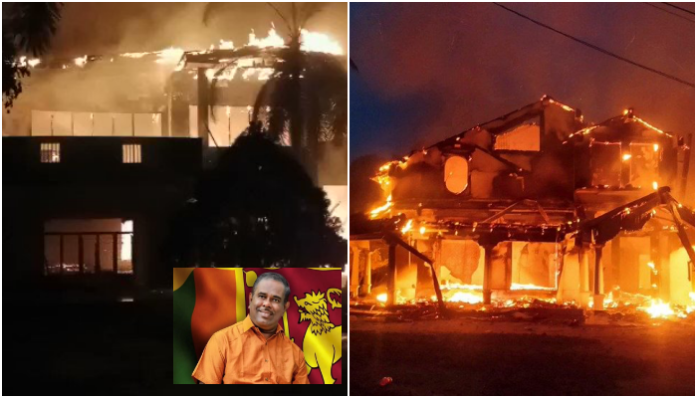Sri Lanka is experiencing unparalleled economic turbulence since gaining independence from the United Kingdom in 1948. A lack of foreign currency has contributed to the issue, since the country has been unable to pay for imports of basic goods and gasoline, resulting in severe shortages and exorbitant costs. Since April 9, tens of thousands of people have taken to the streets across Sri Lanka, demanding President Gotabaya and Prime Minister Mahinda’s resignations because the government has run out of money to pay for basic imports, and there are severe shortages of fuel, medicines, and electricity.
The island’s economic crisis is altering political dynamics both within and beyond the country, while India-China brinkmanship remains unabated. The poorest people in Sri Lanka have been impacted the hardest by the country’s economic turmoil. Except for the power outages, it’s mostly business as usual for Colombo’s aristocracy and upper middle class. A random flare of light from a posh hotel or posh apartment complex bursting through the dark streets of the capital—lights are switched off to save electricity—is a reminder that the city still offers what it did before the crisis behind the closed doors of the affluent and powerful.
The disparity in the country’s metropolitan landscape is exacerbated by the fact that some fancy hotels and highrise gated communities appear to be untouched by the blackouts. They just stored enough fuel to keep their generators running properly and provide adequate power backup. Although the top crust of society has become more careful about flaunting their wealth during such a time, live events, performances, and parties at nightclubs, pubs, and high-end houses across Colombo tell a different narrative.
According to the news agency AFP, a legislator from Sri Lanka’s ruling party, Amarakeerthi Athukorala, was found dead outside the capital Colombo on Monday after a battle with anti-government protesters, while dozens were injured elsewhere. Athukorala allegedly opened fire at Nittambuwa, seriously injuring two individuals who were blocking his car, and was later discovered dead after attempting to take sanctuary in a neighbouring building.
The news comes as Prime Minister Mahinda Rajapaksa announced his resignation in the midst of the island nation’s worst economic crisis since independence, which has sparked huge protests. “The prime minister has sent the president his letter of resignation,” a source stated on condition of anonymity.
The prime minister’s younger brother, President Gotabaya Rajapaksa, is the president. The worst fights since the crisis began erupted in Colombo on Monday, when fans of the Rajapaksa family went on the rampage. Police used tear gas and water cannon and proclaimed an instant curfew in Colombo, which was eventually extended to the entire 22-million-strong South Asian island nation. At least 78 persons were injured, according to Pushpa Soysa, a spokeswoman for the Colombo National Hospital. The army riot squad was brought in to help police, according to officials. Soldiers have been deployed throughout the crisis to secure fuel and other crucial deliveries, but until now, no one has been killed now not to prevent clashes.
Since April 9, AFP correspondents have reported that scores of Rajapaksa supporters have attacked unarmed demonstrators camped outside the president’s office on the seafront Galle Face promenade in downtown Colombo. Several thousand followers of Mahinda Rajapaksa streamed out of his adjacent official mansion, carried in by buses from rural areas. Rajapaksa spoke to a crowd of 3,000 supporters at his home, promising to “defend the nation’s interests.”
On Monday, a Sri Lankan legislator from the ruling Rajapaksa family and two others were found dead in the country during violent skirmishes between anti- and pro-government protestors. Anti-government groups surrounded Amarakeerthi Athukorala, a 57-year-old SLPP MP from the Polonnaruwa district, in the northwestern town of Nittambuwa, according to police. People claimed that gunshots came from his SUV, and that when the enraged mobs overturned it, he rushed to a building and committed suicide by drawing his own revolver. Thousands of people had gathered around the structure by the time he committed suicide. The legislator and his personal security officer were later discovered dead, according to the authorities.
According to the News First website, a 27-year-old guy was also killed in the shooting. Meanwhile, following the violent attacks on peaceful protestors in Colombo’s GotaGoGama’ and MynaGoGama’ demonstration sites, the law-and-order situation spiralled out of control, with many more SLPP lawmakers’ residences being targeted. Angry crowds stormed former minister Johnston Fernando’s offices in Kurunegala and Colombo. His taverns were set on fire as well. Former minister Nimal Lanza’s home was attacked, while Mayor Saman Lal Fernando’s home was set on fire. The mansion of ruling party Trade Leader Mahinda Kahandagamage in Colombo was also targeted. Earlier in the day, he was spotted leading the charge at the two protest sites, according to the report.
After supporters of Mahinda Rajapaksa, who resigned as Prime Minister, attacked nonviolent protestors, the entire country erupted in violence. As they were leaving the capital to return home, the populace turned against the pro-Rajapaksa supporters. In most towns, their vehicles were stopped and attacked. At least 174 people were injured as Mahinda Rajapaksa’s supporters beat anti-government protestors outside President Gotabaya Rajapaksa’s office, forcing authorities to declare a statewide curfew and deploy army soldiers in the city.



